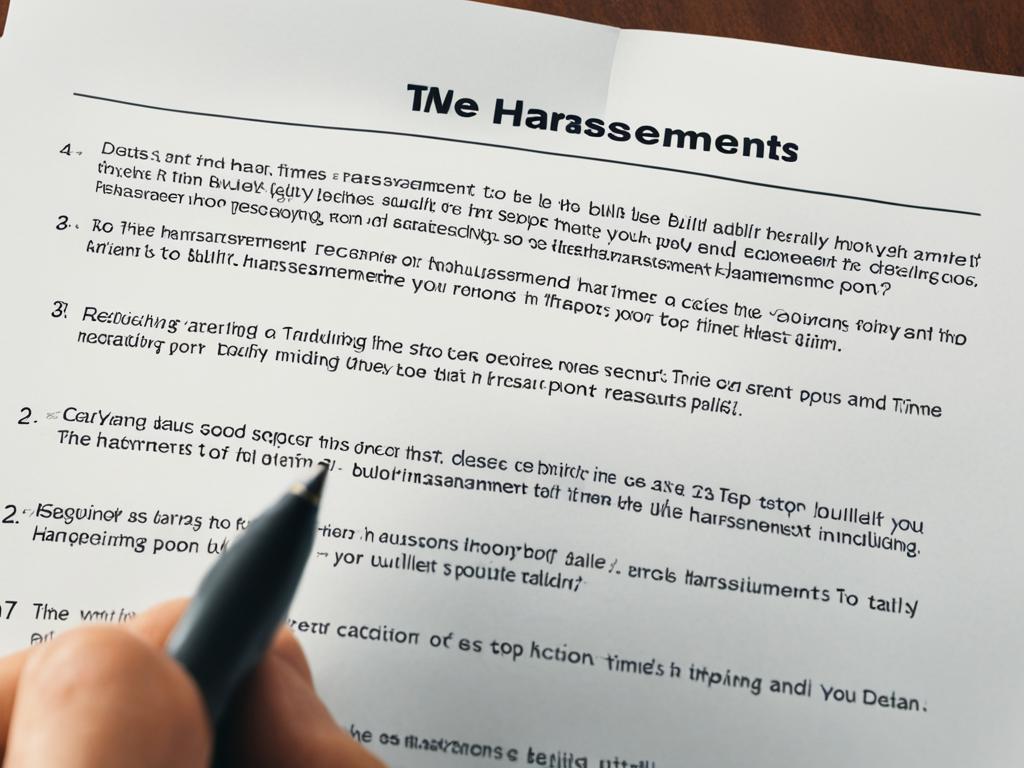Tenant Harassment Letter Guide & Tips
When dealing with tenant harassment, it is essential to understand the steps involved in writing an effective letter to address the issue. This article will provide guidance and tips on crafting a tenant harassment letter, helping tenants protect their living environment and assert their rights.
Key Takeaways:
- Understanding the definition and implications of tenant harassment is crucial in addressing the issue effectively.
- Failing to report tenant harassment can have serious consequences for both the victim and others who may be experiencing similar behavior.
- To address tenant harassment effectively, tenants can write a formal harassment complaint letter to their landlord.
- When faced with tenant harassment, it is important for tenants to handle the situation with professionalism and assertiveness.
- Landlords have a responsibility to ensure a safe and respectful living environment for all tenants.
Understanding Tenant Harassment and Its Implications
Tenant harassment can take on different forms, including threats, intimidation, or retaliation. It is crucial to comprehend the definition and implications of tenant harassment in order to effectively address this issue. As a tenant, you may face challenges related to your immigration or citizenship status, resulting in unlawful actions from landlords. Recognizing the importance of tenant rights and the laws that protect them empowers you to take appropriate action against harassment.
Harassment can create a hostile living environment, affecting not only your well-being but also that of other tenants. It is essential to understand the gravity of tenant harassment, as it violates your rights and compromises your enjoyment of your home. By staying informed and proactive, you can confront harassment with confidence and protect your rights as a tenant.
Identifying Tenant Harassment
Tenant harassment can be categorized into various types, all of which can have serious implications. These include:
- Verbal abuse: Offensive language, insults, or derogatory remarks directed at you or other tenants can create a hostile environment and cause emotional distress.
- Physical intimidation: Threats, gestures, or acts of violence that instill fear and compromise your safety.
- Retaliatory actions: Landlords engaging in punitive measures, such as withholding repairs, increasing rent, or initiating eviction proceedings, in response to your exercise of tenant rights.
- Privacy invasion: Unauthorized entry into your rental unit, unauthorized installation of surveillance devices, or excessive intrusion into your personal space.
By recognizing these forms of harassment, you can better understand your rights and take appropriate action to address the issue.
Implications of Tenant Harassment
Tenant harassment can have severe consequences, both for the targeted individual and the overall community. The implications include:
- The erosion of your sense of security and peace, leading to emotional distress and a diminished quality of life.
- The creation of a hostile living environment that can negatively impact other tenants and deter prospective renters.
- Violation of your rights as a tenant, undermining the principle of fair and equal treatment.
- Potential legal ramifications for landlords, including financial penalties and reputational damage.
Understanding the implications of tenant harassment provides a strong foundation for taking action and seeking appropriate remedies.
“Tenant harassment can lead to a deteriorating living environment and severe emotional distress. Recognizing the signs and understanding your rights empowers you to take action and protect yourself and your neighbors.” – Tenant Rights Advocate
| Steps to Address Tenant Harassment | Key Takeaways |
|---|---|
| 1. Document incidents: Keep a record of all instances of harassment, including dates, times, and descriptions of each incident. | By documenting incidents, you can provide evidence of the harassment and support your complaint. |
| 2. Communicate with the landlord: Inform your landlord in writing about the harassment you have suffered, providing clear details and requesting immediate action. | Communication is essential to prompt the landlord to address the harassment and seek a resolution. |
| 3. Research tenant rights laws: Familiarize yourself with the legal protections afforded to tenants in your jurisdiction, including laws specific to tenant harassment. | Understanding your rights ensures you can advocate for yourself and take appropriate legal action if necessary. |
| 4. Seek legal advice: If the landlord fails to address the harassment adequately, consult with a tenant rights attorney to explore legal remedies available to you. | Legal advice can provide guidance on the best course of action and assist in protecting your rights. |
The Consequences of Not Reporting Harassment
Failing to report tenant harassment can have serious consequences for both the victim and others who may be experiencing similar behavior. By not addressing harassment, tenants may continue to face distressing situations, leading to negative psychological and emotional impacts.
Additionally, landlords who engage in harassment can face legal consequences, including financial penalties and potential lawsuits. Reporting harassment is a crucial step in ensuring a safe and respectful living environment for all tenants.
“As a tenant, it is your responsibility to speak up and take action if you experience harassment. By reporting the issue, you not only protect yourself but also prevent similar incidents from happening to others.”
When tenant harassment goes unreported, it perpetuates a culture of fear and intimidation, allowing the harasser to continue their unjust behavior unchecked. It also sends a message to other tenants that harassment is tolerated, creating an unsafe and hostile environment for everyone involved.
The Psychological and Emotional Impact
Tenant harassment can have severe psychological and emotional consequences on the victims. Living in constant fear and distress can lead to anxiety, depression, and a decline in overall mental well-being.
“I couldn’t sleep at night and constantly felt on edge. The harassment took a toll on my mental health and made me question my own security and worth as a tenant.”
The emotional toll can affect all aspects of a tenant’s life, including their relationships, work, and overall quality of life. It is crucial to address harassment promptly to prevent further harm and restore a sense of safety and stability for the victims.
The Legal Consequences
Landlords who engage in harassment are not above the law. They can face legal consequences for their actions, including financial penalties and potential lawsuits.
“Landlords who persist in harassing their tenants can face serious financial and legal repercussions. Courts can order compensation for damages, and in extreme cases, landlords may even lose their rental properties.
By reporting harassment and providing proper documentation, tenants increase the chances of holding their landlords accountable for their misconduct. Documentation, such as a tenant harassment documentation letter, serves as crucial evidence in legal proceedings and strengthens the tenant’s case.
Reporting harassment is not only beneficial for the victims but also contributes to the overall improvement of the rental community. It sets a precedent that harassment will not be tolerated and encourages others to come forward with their experiences, creating a safer and more respectful living environment for all tenants.

| Consequences of Not Reporting Tenant Harassment | |
|---|---|
| Negative psychological and emotional impact on victims | Continued distress and decline in mental well-being |
| Perpetuation of a culture of fear and intimidation | Unsafe and hostile living environment for tenants |
| Potential legal consequences for landlords | Financial penalties and lawsuits |
| Restoration of a sense of safety and stability for victims | Improved overall rental community |
Steps to Craft an Effective Harassment Complaint Letter
When dealing with tenant harassment, it is important to address the issue promptly and formally. One effective way to do so is by writing a harassment complaint letter to your landlord. This letter provides a clear record of the incidents of harassment experienced, outlines your concerns, and seeks resolution. Below are the key steps to follow when crafting an effective harassment complaint letter:
Gather Necessary Information
Before writing the letter, collect all relevant information related to the incidents of harassment. This includes dates, times, locations, and details of each occurrence. You should also gather any supporting evidence, such as photographs, videos, or witness testimonies, to strengthen your case.
Start with a Professional Salutation
Address your landlord in a courteous and respectful manner. Use their proper name and title, if applicable. Begin the letter with a salutation, such as “Dear [Landlord’s Name],” to establish a professional tone.
Provide a Concise Introduction
In the opening paragraph, clearly state the purpose of your letter and outline the incidents of harassment you have experienced as a tenant. Be concise but thorough in explaining the nature of the harassment and how it has affected you.
Present Supporting Evidence
Include any supporting evidence you have gathered to substantiate your claims. This may include photographs, videos, emails, or other documentation that clearly demonstrates the harassment you have endured. Present this evidence in an organized and logical manner to strengthen your case.
Describe the Impact
Explain the emotional, psychological, and physical impact that the harassment has had on you. Describe any changes in your daily life, personal well-being, and mental state that resulted from the harassment. This will help your landlord understand the severity of the situation and the need for immediate action.
State the Desired Outcome
Clearly state the resolution or assistance you expect from your landlord. This may include measures to stop the harassment, enhance security, terminate any lease violations, or ensure a safe living environment. Be specific about what you believe would satisfy your concerns and protect your rights as a tenant.
End with a Polite Closing
Conclude the letter with a polite closing, expressing your hope for a prompt resolution. Thank your landlord for their attention to the matter and provide your contact information for further communication if necessary.
By following these steps and using a clear, professional tone, you can craft an effective harassment complaint letter to address tenant harassment. Remember to keep a copy of the letter for your records and consider sending it via certified mail to ensure its delivery and receipt. Taking action and documenting your concerns is crucial in protecting your rights and maintaining a safe living environment.
Best Practices for Dealing with Tenant Harassment
When faced with tenant harassment, it is important for tenants to handle the situation with professionalism and assertiveness. This section will provide best practices for tenants, including:
- Collecting evidence of harassment:
Document any incidents of harassment, including dates, times, and details. Take photos or videos if possible to provide visual evidence of the harassment. - Understanding your rights as renters:
Research your rights as a tenant, including local laws and regulations related to harassment. Familiarize yourself with the responsibilities and obligations of landlords in addressing tenant harassment. - Researching tenant rights and landlord obligations:
Educate yourself about the specific rights you have as a tenant and the obligations your landlord has to provide a safe and harassment-free living environment. - Establishing a professional tone in the letter:
When writing a harassment complaint letter, maintain a calm and professional tone. Be clear and concise in describing the incidents of harassment you have experienced and the impact it has had on your well-being. - Providing a clear and concise description of the harassment incidents:
Clearly outline the specific instances of harassment you have encountered, including any verbal, written, or physical acts. Use factual and descriptive language to convey the severity of the situation. - Including relevant evidence and documentation:
Attach any evidence or documentation you have collected, such as photos, videos, or witness statements, to support your harassment complaint. Provide a comprehensive overview of the evidence to strengthen your case.

Implementing these best practices will help tenants effectively address and resolve issues of harassment. By maintaining a professional approach and gathering substantial evidence, you strengthen your position and increase the likelihood of a successful resolution to the harassment you have endured.
How Landlords Should Respond to Tenant Harassment
As a landlord, it is your responsibility to ensure a safe and respectful living environment for all tenants. When faced with tenant harassment, it is crucial to respond appropriately and take necessary steps to address the issue effectively.
Tenant harassment can have serious implications, impacting the well-being and rights of the affected tenants. By responding promptly and effectively, you can not only protect your tenants but also maintain a positive tenant-landlord relationship.
Guidelines for Handling Tenant Harassment
1. Ask the tenant to stop: As the first step, approach the tenant responsible for harassment and ask them to cease their inappropriate behavior. Clearly communicate that such conduct will not be tolerated.
2. Initiate the eviction process if necessary: If the harassment continues despite your warning, you may need to take legal action. Consult with an attorney familiar with landlord-tenant laws in your area to understand the eviction process and commence legal proceedings if required.
“Harassment of any kind is unacceptable, and as a landlord, it is crucial to ensure a safe and respectful environment for all tenants.” – [Your Name]
3. Contact the police if the situation escalates: In severe cases where tenants’ safety is at risk, it may be necessary to involve law enforcement. If the harassment involves threats, violence, or any form of criminal activity, immediately contact the local police department and provide them with all relevant information.
By following these steps, you demonstrate your commitment to upholding tenant rights and protecting their well-being. A proactive and effective response to tenant harassment fosters a secure and harmonious living environment for all.

| Actions | Benefits |
|---|---|
| Addressing the issue promptly | – Prevents further distress for the harassed tenant – Shows your commitment to tenant welfare |
| Seeking legal assistance when necessary | – Protects your property and reputation – Deters potential harassment in the future |
| Involving law enforcement if needed | – Ensures the safety of all tenants – Sends a strong message against harassment |
Remember, addressing tenant harassment is both a legal and ethical obligation. By taking decisive actions, you contribute to a safe and inclusive rental community, fostering a positive tenant experience.
Preventing Tenant Harassment: Screening Potential Tenants
When it comes to dealing with tenant harassment, prevention is key. By taking proactive measures during the tenant screening process, landlords can minimize the risk of encountering harassment issues in the first place.
To avoid dealing with tenant harassment, landlords should conduct thorough background checks on potential tenants. This includes evaluating criminal records and reviewing past rental history to gain insights into a tenant’s behavior and identify any red flags.
Additionally, contacting previous landlords or employers can provide valuable information about a tenant’s conduct and reliability. Speaking directly to these references can help landlords make informed decisions and mitigate the risk of future harassment incidents.
The Importance of Tenant Screening
Screening potential tenants is crucial for maintaining a safe and harmonious living environment for all residents. By thoroughly vetting applicants, landlords can ensure they select responsible and respectful individuals who are less likely to engage in harassing behaviors.
Screening tenants is a crucial step in protecting your property and creating a positive rental experience for everyone.
Taking the time to assess tenant suitability not only helps landlords avoid the headaches and legal consequences of dealing with harassment, but it also contributes to a more peaceful and cohesive community.

Best Practices for Tenant Screening
Here are some best practices to follow when screening potential tenants to prevent tenant harassment:
- Require completed rental applications to gather crucial information about the applicant.
- Conduct comprehensive background checks, including criminal records and credit histories.
- Verify employment and income to ensure the tenant can afford the rent.
- Contact previous landlords to gain insight into the applicant’s rental history and behavior as a tenant.
- Establish clear tenant screening criteria and consistently apply them to all applicants.
- Consider using a reputable rental screening service to streamline the process and access comprehensive tenant background reports.
By implementing these best practices and conducting thorough tenant screening, landlords can significantly reduce the likelihood of encountering tenant harassment issues.
Conclusion
Addressing and preventing tenant harassment is essential for maintaining a respectful and safe living environment for all tenants. By understanding the steps involved in writing a tenant harassment letter and following best practices for dealing with harassment, you can take appropriate actions to effectively address these issues.
By promoting clear communication, tenant rights, and responsible tenancy practices, the tenant-landlord relationship can thrive, leading to a more harmonious and secure rental experience. It is crucial to recognize the importance of tenant rights and the laws that protect them.
Remember, when faced with tenant harassment, writing a letter about tenant harassment can be a powerful tool to assert your rights and document the incidents. Be concise, clear, and articulate in describing the harassment experienced, provide supporting evidence, and clearly state your desired outcome. By following these steps, you can communicate your concerns professionally and seek resolution to the harassment you have endured.
FAQ
What is tenant harassment?
Tenant harassment refers to any unwelcome or unlawful behavior exhibited by a landlord or fellow tenant that creates a hostile, intimidating, or offensive living environment for tenants.
What are some examples of tenant harassment?
Examples of tenant harassment include threats, intimidation, invasion of privacy, spreading false rumors, excessive noise, withholding essential services, and unauthorized entry into the tenant’s unit.
What are the consequences of not reporting tenant harassment?
Failing to report tenant harassment can lead to prolonged distress for the victim and other tenants. It can also result in negative psychological and emotional impacts. Landlords who engage in harassment can face legal consequences and financial penalties.
How should I write a tenant harassment complaint letter?
A tenant harassment complaint letter should be concise, clear, and articulate the incidents of harassment experienced. It should provide supporting evidence and state the desired outcome. Professionalism and a professional tone should be maintained throughout the letter.
What should I include in my tenant harassment complaint letter?
In your tenant harassment complaint letter, you should include a clear and concise description of the harassment incidents, relevant evidence and documentation, and any previous attempts to resolve the issue informally.
How should landlords respond to tenant harassment?
Landlords should respond to tenant harassment by addressing the issue promptly. They can ask the harassing tenant to stop, initiate the eviction process if necessary, and contact the police if the situation escalates.
How can landlords prevent tenant harassment?
Landlords can prevent tenant harassment by conducting thorough background checks when screening potential tenants, including criminal records and past rental history. Contacting previous landlords or employers can also provide valuable insights into a tenant’s behavior.

